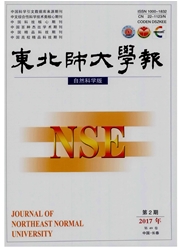

 中文摘要:
中文摘要:
Effect of the cationic surfactant on the hydrolysis of acrylic staple fiber dispersed in alkaline aqueous solution was studied.The cationic dyestuff uptake of the resultant hydrolysates was investigated as well.The results showed that the surfactant accelerated the hydrolysis of cyano-and ester-groups.The carboxyl content of the hydrolyzed fibers reached the maximum 6.85 mmol/g(i.e.,total molar conversion of the two groups 38.7%) while keeping fiber integrity.The scanning electron microscopy(SEM) images implied that hydrolysis happened both on fiber surface and in the inner part of the fiber in the presence of surfactant.The cationic dye removal due to adsorption onto the hydrolyzed fibers increased with increasing temperature,with the removal 97.4% at 60℃.The adsorption of the fibers followed the Freundlich’s adsorption isotherm and the Lagergren’s pseudo-second order dynamic equation with the activation energy 5.4 kJ/mol.Unexpectedly,the steric hindrance of access to the inside carboxyl groups of the hydrolyzed fibers caused a low dye sorption capacity,5-6 mg/g.
 英文摘要:
英文摘要:
Effect of the cationic surfactant on the hydrolysis of acrylic staple fiber dispersed in alkaline aqueous solution was studied.The cationic dyestuff uptake of the resultant hydrolysates was investigated as well.The results showed that the surfactant accelerated the hydrolysis of cyano-and ester-groups.The carboxyl content of the hydrolyzed fibers reached the maximum 6.85 mmol/g(i.e.,total molar conversion of the two groups 38.7%) while keeping fiber integrity.The scanning electron microscopy(SEM) images implied that hydrolysis happened both on fiber surface and in the inner part of the fiber in the presence of surfactant.The cationic dye removal due to adsorption onto the hydrolyzed fibers increased with increasing temperature,with the removal 97.4% at 60℃.The adsorption of the fibers followed the Freundlich's adsorption isotherm and the Lagergren's pseudo-second order dynamic equation with the activation energy 5.4 kJ/mol.Unexpectedly,the steric hindrance of access to the inside carboxyl groups of the hydrolyzed fibers caused a low dye sorption capacity,5-6 mg/g.
 同期刊论文项目
同期刊论文项目
 同项目期刊论文
同项目期刊论文
 期刊信息
期刊信息
